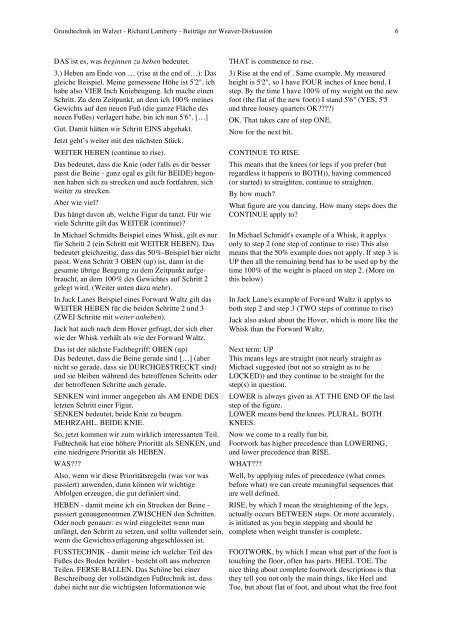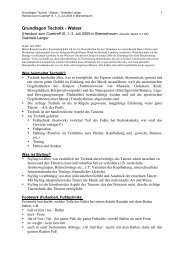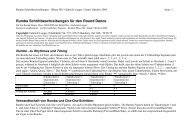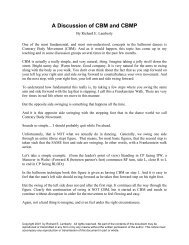Grundtechnik im Walzer - Richard Lamberty
Grundtechnik im Walzer - Richard Lamberty
Grundtechnik im Walzer - Richard Lamberty
Sie wollen auch ein ePaper? Erhöhen Sie die Reichweite Ihrer Titel.
YUMPU macht aus Druck-PDFs automatisch weboptimierte ePaper, die Google liebt.
<strong>Grundtechnik</strong> <strong>im</strong> <strong>Walzer</strong> - <strong>Richard</strong> <strong>Lamberty</strong> - Beiträge zur Weaver-Diskussion 6<br />
DAS ist es, was beginnen zu heben bedeutet. THAT is commence to rise.<br />
3.) Heben am Ende von … (rise at the end of…): Das<br />
gleiche Beispiel. Meine gemessene Höhe ist 5'2", ich<br />
habe also VIER Inch Kniebeugung. Ich mache einen<br />
Schritt. Zu dem Zeitpunkt, an dem ich 100 % meines<br />
Gewichts auf den neuen Fuß (die ganze Fläche des<br />
neuen Fußes) verlagert habe, bin ich nun 5'6". […]<br />
Gut. Damit hätten wir Schritt EINS abgehakt.<br />
Jetzt geht’s weiter mit den nächsten Stück.<br />
WEITER HEBEN (continue to rise).<br />
Das bedeutet, dass die Knie (oder falls es dir besser<br />
passt die Beine - ganz egal es gilt für BEIDE) begonnen<br />
haben sich zu strecken und auch fortfahren, sich<br />
weiter zu strecken.<br />
Aber wie viel?<br />
Das hängt davon ab, welche Figur du tanzt. Für wie<br />
viele Schritte gilt das WEITER (continue)?<br />
In Michael Schmidts Beispiel eines Whisk, gilt es nur<br />
für Schritt 2 (ein Schritt mit WEITER HEBEN). Das<br />
bedeutet gleichzeitig, dass das 50 %-Beispiel hier nicht<br />
passt. Wenn Schritt 3 OBEN (up) ist, dann ist die<br />
gesamte übrige Beugung zu dem Zeitpunkt aufgebraucht,<br />
an dem 100 % des Gewichtes auf Schritt 2<br />
gelegt wird. (Weiter unten dazu mehr).<br />
In Jack Lanes Beispiel eines Forward Waltz gilt das<br />
WEITER HEBEN für die beiden Schritte 2 und 3<br />
(ZWEI Schritte mit weiter anheben).<br />
Jack hat auch nach dem Hover gefragt, der sich eher<br />
wie der Whisk verhält als wie der Forward Waltz.<br />
Das ist der nächste Fachbegriff: OBEN (up)<br />
Das bedeutet, dass die Beine gerade sind […] (aber<br />
nicht so gerade, dass sie DURCHGESTRECKT sind)<br />
und sie bleiben während des betroffenen Schritts oder<br />
der betroffenen Schritte auch gerade.<br />
SENKEN wird <strong>im</strong>mer angegeben als AM ENDE DES<br />
letzten Schritt einer Figur.<br />
SENKEN bedeutet, beide Knie zu beugen.<br />
MEHRZAHL. BEIDE KNIE.<br />
So, jetzt kommen wir zum wirklich interessanten Teil.<br />
Fußtechnik hat eine höhere Priorität als SENKEN, und<br />
eine niedrigere Priorität als HEBEN.<br />
WAS???<br />
Also, wenn wir diese Prioritätsregeln (was vor was<br />
passiert) anwenden, dann können wir wichtige<br />
Abfolgen erzeugen, die gut definiert sind.<br />
HEBEN - damit meine ich ein Strecken der Beine -<br />
passiert genaugenommen ZWISCHEN den Schritten.<br />
Oder noch genauer: es wird eingeleitet wenn man<br />
anfängt, den Schritt zu setzen, und sollte vollendet sein,<br />
wenn die Gewichtsverlagerung abgeschlossen ist.<br />
FUSSTECHNIK - damit meine ich welcher Teil des<br />
Fußes des Boden berührt - besteht oft aus mehreren<br />
Teilen. FERSE BALLEN. Das Schöne bei einer<br />
Beschreibung der vollständigen Fußtechnik ist, dass<br />
dabei nicht nur die wichtigsten Informationen wie<br />
3) Rise at the end of . Same example. My measured<br />
height is 5'2", so I have FOUR inches of knee bend. I<br />
step. By the t<strong>im</strong>e I have 100% of my weight on the new<br />
foot (the flat of the new foot)) I stand 5'6" (YES, 5'5<br />
and three lousey quarters OK????)<br />
OK. That takes care of step ONE.<br />
Now for the next bit.<br />
CONTINUE TO RISE.<br />
This means that the knees (or legs if you prefer (but<br />
regardless it happens to BOTH)), having commenced<br />
(or started) to straighten, continue to straighten.<br />
By how much?<br />
What figure are you dancing. How many steps does the<br />
CONTINUE apply to?<br />
In Michael Schmidt's example of a Whisk, it applys<br />
only to step 2 (one step of continue to rise) This also<br />
means that the 50% example does not apply. If step 3 is<br />
UP then all the remaining bend has to be used up by the<br />
t<strong>im</strong>e 100% of the weight is placed on step 2. (More on<br />
this below)<br />
In Jack Lane's example of Forward Waltz it applys to<br />
both step 2 and step 3 (TWO steps of continue to rise)<br />
Jack also asked about the Hover, which is more like the<br />
Whisk than the Forward Waltz.<br />
Next term: UP<br />
This means legs are straight (not nearly straight as<br />
Michael suggested (but not so straight as to be<br />
LOCKED)) and they continue to be straight for the<br />
step(s) in question.<br />
LOWER is always given as AT THE END OF the last<br />
step of the figure.<br />
LOWER means bend the knees. PLURAL. BOTH<br />
KNEES.<br />
Now we come to a really fun bit.<br />
Footwork has higher precedence than LOWERING,<br />
and lower precedence than RISE.<br />
WHAT???<br />
Well, by applying rules of precedence (what comes<br />
before what) we can create meaningful sequences that<br />
are well defined.<br />
RISE, by which I mean the straightening of the legs,<br />
actually occurs BETWEEN steps. Or more accurately,<br />
is initiated as you begin stepping and should be<br />
complete when weight transfer is complete.<br />
FOOTWORK, by which I mean what part of the foot is<br />
touching the floor, often has parts. HEEL TOE. The<br />
nice thing about complete footwork descriptions is that<br />
they tell you not only the main things, like Heel and<br />
Toe, but about flat of foot, and about what the free foot






